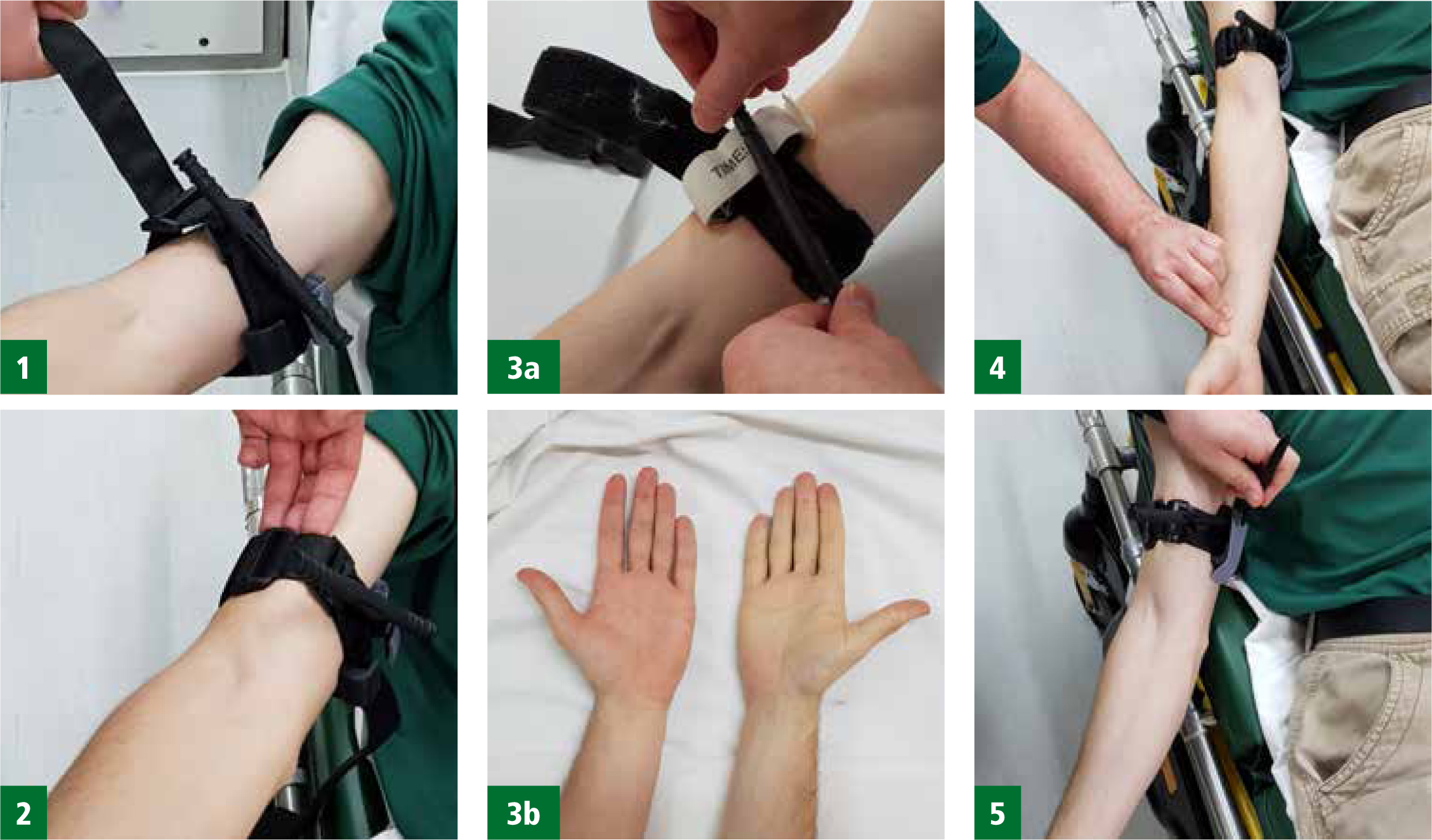
This first article in the Journal of Paramedic Practice's monthly Clinical Skills feature highlights best practice use of a Combat Application Tourniquet® (CAT®). It also provides background information relating to the use of a CAT in the clinical practice setting.
What is a tourniquet?
A ‘tourniquet’ or CAT is a device designed to specifically occlude arterial and venous blood flow in an extremity. To do this, it uses a mechanical advantage device, differing from ligature type devices used for intravenous cannulation and other procedures (Amy et al, 2014).
The CAT is a unique piece of medical equipment as it can save a patient from exsanguination (severe uncontrolled blood loss). However, if used inappropriately, it can cause injuries to be significantly worsened to the point that a limb may need to be amputated (Lee et al, 2007; Dayan et al, 2008).
It is important to note that when referring to any bleeding or injury in this article, unless specified otherwise, the author is referring to a peripheral limb. Furthermore, CAT tourniquets should only be applied for extremity trauma (Lee et al, 2007).
History of the CAT
The first recorded use of a tourniquet type device goes back to 1674 at the battle of Flanders (Welling et al, 2012). The techniques were not refined and, in many cases, were not easy to perform. As time progressed, however, the tourniquet has developed; and not only for in-hospital use, but for pre-hospital use as well. This led to the development of devices such as the CAT (Welling et al, 2012).
The CAT was introduced because of a need from the military to treat injured soldiers who would otherwise die on the field from simple extremity exsanguination (Kragh et al, 2009). According to a study on a conflict by Lakstein et al (2003), 10% of soldiers would have died before arriving at a surgical unit. The causative factor for the death of these solders would be catastrophic haemorrhage. The CAT would have been capable of controlling the bleeding for approximately half of these patients (Lakstein et al, 2003).
Learning Points
International use of CAT
It is worth noting that the CAT tourniquet is accepted and used internationally in countries such as South Africa, Australia, the United States (US) and the UK (Lee et al, 2007; Dayan et al, 2008; South Western Ambulance Service NHS Foundation Trust, 2013; Campbell, 2014; Queensland, 2016). With a high number of practitioners using this device across the world, it is essential to understand how to apply it correctly.
Safe and effective use
To be able to use a tourniquet effectively and ensure patient safety when using the device, there are considerations that should be understood. There are indications, directions for use and contraindications, all applicable for CAT tourniquet use.
Catastrophic haemorrhage
The true indication of a tourniquet is a ‘catastrophic’ haemorrhage that is uncontrolled (South Western Ambulance Service NHS Foundation Trust, 2013). This may be difficult to explain as the term ‘catastrophic’, has a subjective meaning which could lead to inappropriate use. Haemorrhage is defined as ‘bleeding, which may be pooled or active’ (Anon, 2012). This very broad definition of a haemorrhage has inadvertently led to inappropriate application of the CAT tourniquet in a number of instances in clinical practice (Lee et al, 2007).
It is important to note that a contraindication for the use of a CAT is that it should not be used on a patient with a haemorrhage that can be controlled by other measures, such as direct pressure (Lee et al, 2007). Therefore, a simpler explanation of when the CAT should be applied is when a life-threatening haemorrhage occurs to an extremity, and it cannot be controlled by any other means in the environment in which the practitioner is working (Lee et al, 2007; South Western Ambulance Service NHS Foundation Trust, 2013; Queensland, 2016).
Structured approach
Upon identification of a life-threatening haemorrhage, the practitioner should assess and manage the patient using a structured ‘CABC’ approach as follows:
The simple 5-step approach to a CAT application is as follows and is demonstrated in Figure 1:

Another important consideration is that the CAT should be used directly on the skin and not over clothing. If any objects or thick clothing are present, the procedure may be ineffective (Lakstein et al, 2003).
Managing risks of CAT
The CAT tourniquet should only be used when indicated. If used inappropriately, the patient could continue to bleed or even lose a limb (Lee et al, 2007; Dayan et al, 2008).
A tourniquet can safely be left on an extremity for 2–4 hours without release. This is a vital aspect of application and necessitates the requirement for the time strap (Campbell, 2014). This is an item that should be applied first when managing a patient to prevent further exsanguination (Lee et al, 2007).
As with any medical procedure, it is recommended that consent be obtained from the patient (Health and Care Professions Council (HCPC), 2016). However, considering the mechanism of injury and complications associated with massive blood loss, the patient may not be able to consent. Patient consent should not delay application of the CAT in cases of life-threating injury in an emergency setting. As this is a time-critical procedure, it may be required to assume implied consent for these patients in order for their best interests to be prioritised (Campbell, 2014; HCPC, 2016).
A more detailed list of complications of tourniquet use includes but is not limited to:
These may lead to ischaemic injury causing the loss of viability of the limb, and resulting in amputation (Lee et al, 2007; Dayan et al, 2008; Queensland, 2016). The cause of the physiological and pathophysiological effects is loss of perfusion to the limb because of a significant compressive force. This limits perfusion causing ischaemia and death of cells. These complications can make the risk/benefit decision challenging for the practitioner; however, they also reinforce the necessity of the presence of appropriate indications.
Frequent and constant training on this device is important as knowledge of mechanical skills can be rapidly lost when not reinforced (Jones, 2006).
An old and inappropriate practice still commonly exists. Periodic loosening of a tourniquet to provide ‘reperfusion’ was thought to be beneficial, but instead resulted in the patient losing extensive blood volume (Cloonan Clifford, 2004). With the timeframe of 2–4 hours, there is no need to release a tourniquet in any environment other than a controlled environment with appropriate surgical staff (Campbell, 2014).
The CAT is a lifesaving device that can be used by almost anyone in the pre-hospital environment, but does have serious adverse effects if used incorrectly. Personnel are required to have training on the device as well as recognising what a life-threatening bleed entails. The device can be left for an extended period of time without adjustment but does require monitoring of the wound itself. The CAT is a device that can buy time, allowing the patient to reach definitive care such as emergency surgery. Without a tourniquet device, the patient will have a higher chance of bleeding out and dying before definitive care can be provided.

